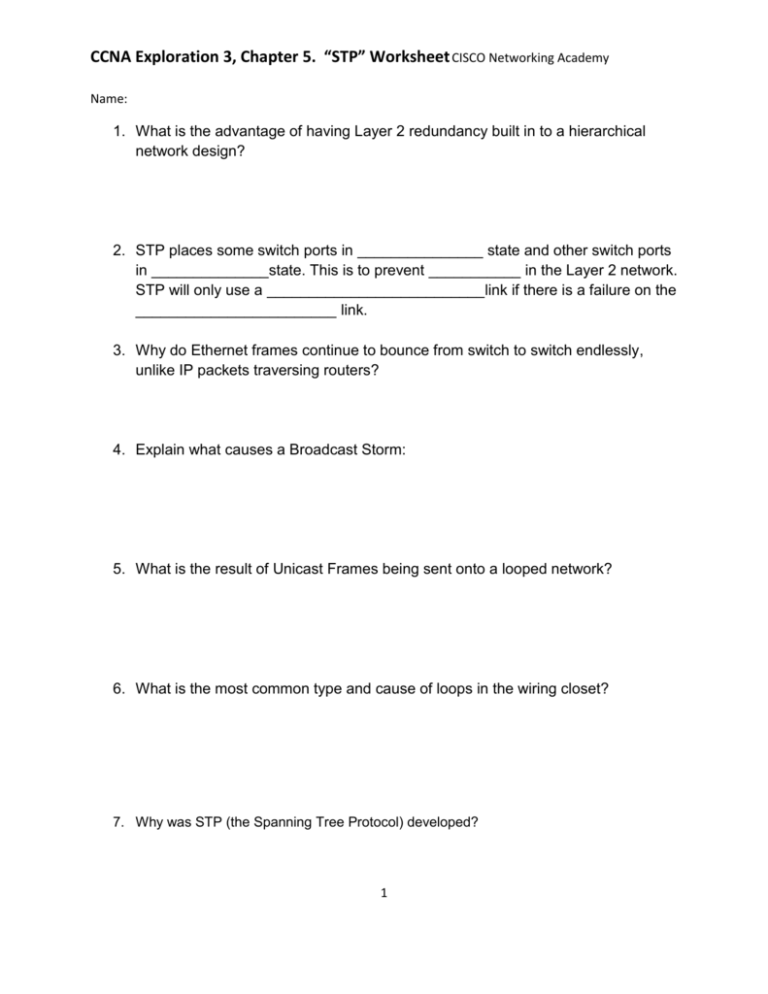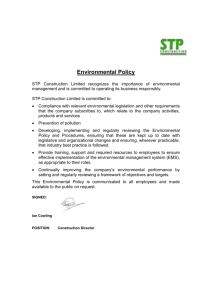CCNA Exploration 3, Chapter 5. “STP” Worksheet CISCO
advertisement

CCNA Exploration 3, Chapter 5. “STP” Worksheet CISCO Networking Academy Name: 1. What is the advantage of having Layer 2 redundancy built in to a hierarchical network design? 2. STP places some switch ports in _______________ state and other switch ports in ______________state. This is to prevent ___________ in the Layer 2 network. STP will only use a __________________________link if there is a failure on the ________________________ link. 3. Why do Ethernet frames continue to bounce from switch to switch endlessly, unlike IP packets traversing routers? 4. Explain what causes a Broadcast Storm: 5. What is the result of Unicast Frames being sent onto a looped network? 6. What is the most common type and cause of loops in the wiring closet? 7. Why was STP (the Spanning Tree Protocol) developed? 1 CCNA Exploration 3, Chapter 5. “STP” Worksheet CISCO Networking Academy 8. What is a BPDU and what is its purpose? 9. STP prevents loops from occurring by configuring a loop-free path through the network using strategically placed _______________state ports. The switches running STP are able to compensate for failures by dynamically _____________________ the previously ____________________ports and permitting traffic to traverse the alternate paths. 10. What is the root bridge and what is its purpose? 11. When an election occurs to determine which switch will become the root bridge, how is the “winner” determined? 12. What three things are contained in a bridge ID (BID)? 13. While the STA determines the best paths to the root bridge for all destinations in the broadcast domain, what happens to traffic on the network? 14. What are Root ports? 15. What are Designated ports? 16. What are Non-Designated ports? 17. What is the role and importance of the Root Bridge? 2 CCNA Exploration 3, Chapter 5. “STP” Worksheet CISCO Networking Academy 18. Describe the root bridge election process: 19. List Link Speeds and their associated costs according to the Revised IEEE Specification: 20. How, and with what command, can an administrator control spanning-tree paths to the root bridge? 21. Path ___________is the sum of all the port _________along the path to the root bridge. The paths with the ______________________ become the preferred path, and all other redundant paths are __________________________. 22. What commands will verify the port and path cost to the root bridge? 23. At the beginning of the STP BPDU/election process, initially, each switch identifies itself as ________________________. 24. If the priority of all the switches is the same, the _____________________MAC address will be the deciding factor. 3 CCNA Exploration 3, Chapter 5. “STP” Worksheet CISCO Networking Academy 25. The bridge ___________________ is a customizable value that you can use to influence which switch becomes the root bridge. The switch with the _____________priority becomes the root bridge. 26. The default value for the priority of all Cisco switches is __________. The priority range is between ___________ and ___________; therefore, _________________is the highest priority. 27. The extended system ID field contains the __________________________ with which the BPDU is associated. 28. Why is it recommended to configure the desired root bridge switch with a lower priority to ensure that it is elected root bridge? 29. Explain the two methods you can use to configure the bridge priority value on a Cisco Catalyst switch: 30. List the four distinct port roles that switch ports are automatically configured for during the spanning-tree process: 4 CCNA Exploration 3, Chapter 5. “STP” Worksheet CISCO Networking Academy 31. The ______________ exists on non-root bridges and is the switch port with the best path to the root bridge. ___________________ forward traffic toward the root bridge. The source MAC address of frames received on the _____________ are capable of populating the MAC table. Only one _____________________ is allowed per bridge. 32. The ____________________________exists on root and non-root bridges. For root bridges, all switch ports are ______________________________. For non-root bridges, a __________________________ is the switch port that receives and forwards frames toward the root bridge as needed. Only one ______________ is allowed per _______. 33. The __________________________ is a switch port that is blocked, so it is not forwarding data frames and not populating the MAC address table with source addresses. A _____________________________ is not a root port or a designated port. 34. The __________________________ is a switch port that is administratively shut down. A ____________________________ does not function in the spanning-tree process. 35. Which switch port is automatically assigned the root port role? 36. The root bridge automatically configures all of its switch ports in the ____________ role. Other switches in the topology configure their ____________________ as designated or non-designated ports. 37. To facilitate the learning of the logical spanning tree, each switch port transitions through what five possible port states? 38. Briefly describe each of the port states listed in the previous question: 5 CCNA Exploration 3, Chapter 5. “STP” Worksheet CISCO Networking Academy 39. The amount of time that a port stays in the various port states depends on the ____________ timers. 40. List and describe these three timers: 41. What is Cisco PortFast and what is its purpose? 42. Define Convergence in relation to the spanning-tree process: 43. What is the first step in the spanning-tree convergence process? 44. When is a root bridge election triggered? 45. Explain why all switch ports are initially in the blocking state: 6 CCNA Exploration 3, Chapter 5. “STP” Worksheet CISCO Networking Academy 46. When does the root bridge election end? 47. What are the default values of the hello timer and the max age timer? 48. What happens when the max age timer expires? 49. After the root bridge is determined, the switches start configuring the port roles for each of their switch ports. The first port role that needs to be determined is the root port role. Explain what happens when two or more ports on the same switch have the same path cost to the root: 50. Explain what is meant by the “seven-switch diameter” that is supported by STP: 51. Define and explain the purpose of a topology change notification (TCN) BPDU: 52. List the Cisco Proprietary variants of spanning tree protocol and their basic characteristics: 7 CCNA Exploration 3, Chapter 5. “STP” Worksheet CISCO Networking Academy 53. List the IEEE Standard variants of STP and their basic characteristics: 54. Why did Cisco develop PVST+? 55. What is the significance of the Extended system ID field in a PVST+ frame? 56. What is the main advantage or RSTP? 57. Describe the meaning and purpose of Edge Ports: 58. Describe the Point to Point Link Type: 8 CCNA Exploration 3, Chapter 5. “STP” Worksheet CISCO Networking Academy 59. Describe the Shared Link Type: 60. List and define/describe the three RSTP Port States: 61. What STP port states were merged into the RSTP discarding port state? 62. List and define each of the RSTP Port Roles that are described in the figure in section 5.4.6.2: 63. Why should you not leave it up to the STP to decide which bridge is root, and what bridge would generally be a good choice? 64. What might be the value of knowing the location of redundant links and blocked ports? 65. What is the advantage of using Layer 3 Switching? 9 CCNA Exploration 3, Chapter 5. “STP” Worksheet CISCO Networking Academy 66. List some reasons why it is a good idea to not disable STP: 67. Why is it a good idea to keep traffic off the Administrative VLAN? 68. What is the main problem with having a single VLAN span the entire network? 10







